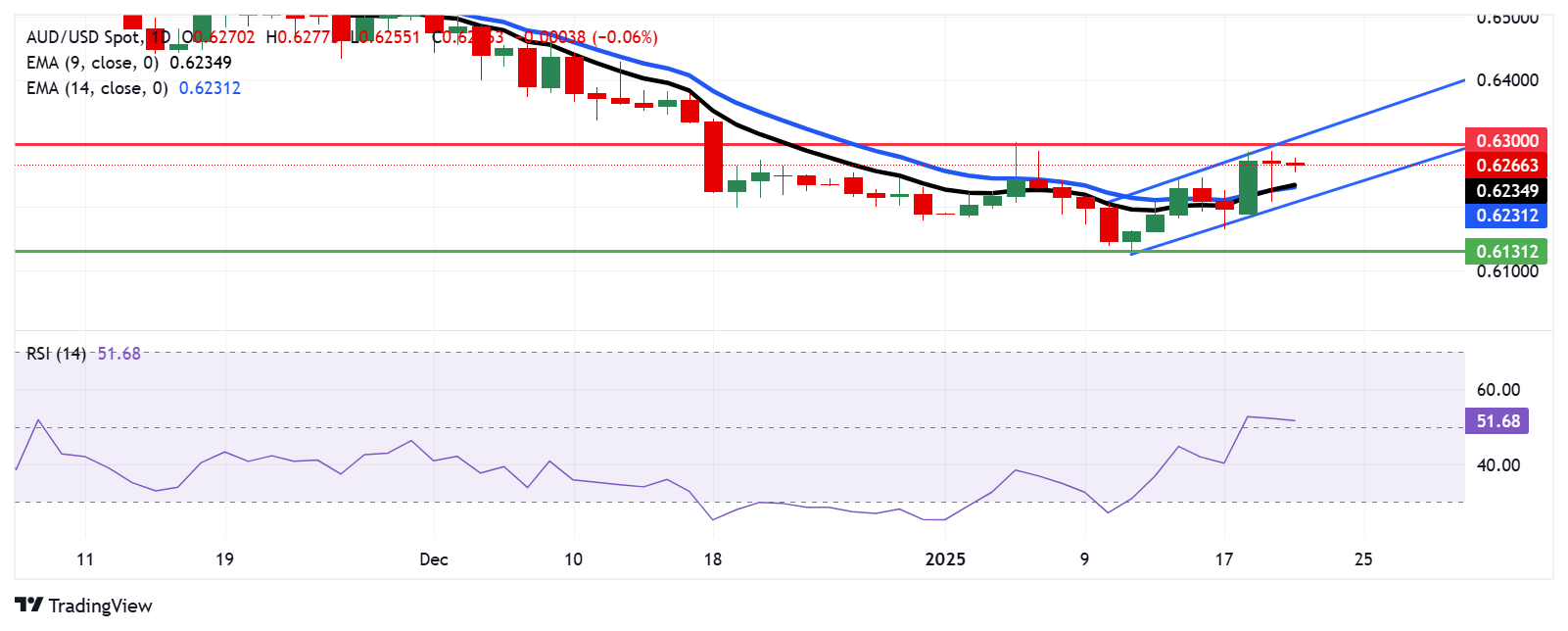- The Australian dollar is facing pressure after President Trump announced that his administration is considering a 10% tariff on Chinese imports.
- Chinese Vice Premier Ding Xuexiang warned of the consequences of a trade war.
- Trump issued a memo directing federal agencies to investigate and address ongoing trade deficits.
The Australian Dollar (AUD) remains under pressure against the US Dollar (USD) on Wednesday. The AUD/USD pair faces challenges as US President Donald Trump announced that his administration is considering imposing a 10% tariff on Chinese imports starting February 1. According to Reuters, the move is reportedly linked to concerns about fentanyl shipments from China to Mexico and Canada.
Trump previously mentioned, “If we make a deal with TikTok and China doesn’t approve it, we could maybe impose tariffs on China.” This comment follows his signing of an executive order delaying enforcement of the TikTok ban for 75 days. Given the close trading relationship between China and Australia, any development affecting the Chinese economy could significantly influence Australian markets.
Chinese Vice Premier Ding Xuexiang issued a warning Tuesday about the repercussions of a trade war, emphasizing that “there are no winners” in such conflicts as China faces the possibility of tariffs under the newly elected Donald Trump administration, according to CNBC.
The S&P/ASX 200 index rose to around 8,450 on Wednesday, marking its highest level in almost seven weeks. The rally was supported by positive momentum from Wall Street, fueled by US President Donald Trump’s decision to delay the implementation of tariff threats, which provided relief to global markets.
Australian Dollar Could Gain Ground as Trump Opts Out of Imposing New Tariffs
- The US Dollar Index (DXY), which tracks the performance of the US Dollar against six major currencies, remains around 108.00 at the time of writing. However, the dollar faced headwinds as President Donald Trump opted not to impose new tariffs on his first day in office. However, Trump issued a memorandum directing federal agencies to investigate and address ongoing trade deficits. Trump also warned Mexico, Canada, China and the EU of possible tariffs over a host of trade concerns.
- The US Federal Reserve (Fed) is expected to keep its benchmark overnight rate in the range of 4.25%-4.50% at its January meeting. However, investors believe Trump’s policies could fuel inflationary pressures, potentially limiting the Fed to just one more rate cut. This could help cushion the USD against significant losses in the near term.
- US retail sales increased 0.4% month-on-month in December, reaching $729.2 billion. This reading was weaker than market expectations of a 0.6% increase and lower than the previous reading of a 0.8% increase (revised from 0.7%).
- The US Consumer Price Index rose 2.9% year-on-year in December, up from 2.7% in November, aligning with market expectations. Monthly, the CPI rose 0.4%, after an increase of 0.3% in the previous month. The US core CPI, which excludes volatile food and energy prices, rose 3.2% annually in December, slightly below the November figure and analysts’ forecasts of 3.3%.
- Australia’s Westpac Leading Index was stable in December 2024, unchanged from the previous month, which had recorded an increase of 0.1%. Meanwhile, the six-month annualized growth rate, a measure of the expected pace of economic activity compared to trend over the next three to nine months, fell to 0.25% in December, from 0.33% in November, but was remained positive for the second consecutive month.
- Traders increasingly expect the Reserve Bank of Australia (RBA) to begin cutting interest rates as early as next month. This outlook is driven by weaker core inflation data, which has fallen to its lowest level since the fourth quarter of 2021, moving closer to the RBA’s target range of 2% to 3%. All eyes are now on Australia’s next quarterly inflation report, due out next week, as it could offer additional clues about the future direction of interest rates.
Australian Dollar holds below 0.6300 but is set to test the upper boundary of the ascending channel
AUD/USD is trading near 0.6270 on Wednesday. An analysis of the daily chart suggests that the pair is moving within an ascending channel pattern, indicating the possible development of a bullish bias. Furthermore, the 14-day Relative Strength Index (RSI) is slightly above the 50 mark, reinforcing the presence of bullish sentiment in the market.
To the upside, the AUD/USD pair could test the psychological resistance level at 0.6300, with the next target being the upper boundary of the ascending channel near 0.6320.
Initial support is seen around the nine-day exponential moving average (EMA) at 0.6235, followed by the 14-day EMA at 0.6231. A stronger support level lies at the lower boundary of the ascending channel around 0.6210, with additional support at the psychological level of 0.6200.
AUD/USD: Daily Chart
Australian Dollar PRICE Today
The table below shows the percentage change of the Australian Dollar (AUD) against major currencies today. Australian dollar was the weakest currency against the Canadian dollar.
| USD | EUR | GBP | JPY | CAD | AUD | NZD | CHF | |
|---|---|---|---|---|---|---|---|---|
| USD | 0.08% | 0.04% | 0.12% | -0.03% | 0.08% | 0.28% | 0.06% | |
| EUR | -0.08% | -0.04% | 0.05% | -0.09% | -0.01% | 0.19% | -0.03% | |
| GBP | -0.04% | 0.04% | 0.08% | -0.07% | 0.04% | 0.24% | 0.02% | |
| JPY | -0.12% | -0.05% | -0.08% | -0.14% | -0.04% | 0.15% | -0.06% | |
| CAD | 0.03% | 0.09% | 0.07% | 0.14% | 0.10% | 0.30% | 0.08% | |
| AUD | -0.08% | 0.00% | -0.04% | 0.04% | -0.10% | 0.20% | -0.02% | |
| NZD | -0.28% | -0.19% | -0.24% | -0.15% | -0.30% | -0.20% | -0.22% | |
| CHF | -0.06% | 0.03% | -0.02% | 0.06% | -0.08% | 0.02% | 0.22% |
The heat map shows percentage changes for major currencies. The base currency is selected from the left column, while the quote currency is selected from the top row. For example, if you choose the Australian Dollar from the left column and move along the horizontal line to the US Dollar, the percentage change shown in the box will represent the AUD (base)/USD (quote).
Australian Dollar FAQs
One of the most important factors for the Australian Dollar (AUD) is the level of interest rates set by the Reserve Bank of Australia (RBA). As Australia is a resource-rich country, another key factor is the price of its largest export, iron ore. The health of the Chinese economy, its largest trading partner, is a factor, as is inflation in Australia, its growth rate and the Balance of Trade. Market sentiment, that is, whether investors bet on riskier assets (risk-on) or seek safe havens (risk-off), is also a factor, with the risk-on being positive for the AUD.
The Reserve Bank of Australia (RBA) influences the Australian Dollar (AUD) by setting the level of interest rates that Australian banks can lend to each other. This influences the level of interest rates in the economy as a whole. The RBA’s main objective is to maintain a stable inflation rate of 2%-3% by adjusting interest rates up or down. Relatively high interest rates compared to other major central banks support the AUD, and the opposite for relatively low ones. The RBA can also use quantitative easing and tightening to influence credit conditions, with the former being negative for the AUD and the latter being positive for the AUD.
China is Australia’s largest trading partner, so the health of the Chinese economy greatly influences the value of the Australian Dollar (AUD). When the Chinese economy is doing well, it buys more raw materials, goods and services from Australia, which increases demand for the AUD and drives up its value. The opposite occurs when the Chinese economy does not grow as fast as expected. Therefore, positive or negative surprises in Chinese growth data usually have a direct impact on the Australian Dollar.
Iron ore is Australia’s largest export, with $118 billion a year according to 2021 data, with China being its main destination. The iron ore price, therefore, may be a driver of the Australian dollar. Typically, if the price of iron ore rises, the AUD also rises as aggregate demand for the currency increases. The opposite occurs when the price of iron ore falls. Higher iron ore prices also tend to result in a higher likelihood of a positive trade balance for Australia, which is also positive for the AUD.
The trade balance, which is the difference between what a country earns from its exports and what it pays for its imports, is another factor that can influence the value of the Australian dollar. If Australia produces highly sought-after exports, its currency will gain value solely from the excess demand created by foreign buyers wanting to purchase its exports versus what it spends on purchasing imports. Therefore, a positive net trade balance strengthens the AUD, with the opposite effect if the trade balance is negative.
Source: Fx Street
I am Joshua Winder, a senior-level journalist and editor at World Stock Market. I specialize in covering news related to the stock market and economic trends. With more than 8 years of experience in this field, I have become an expert in financial reporting.








